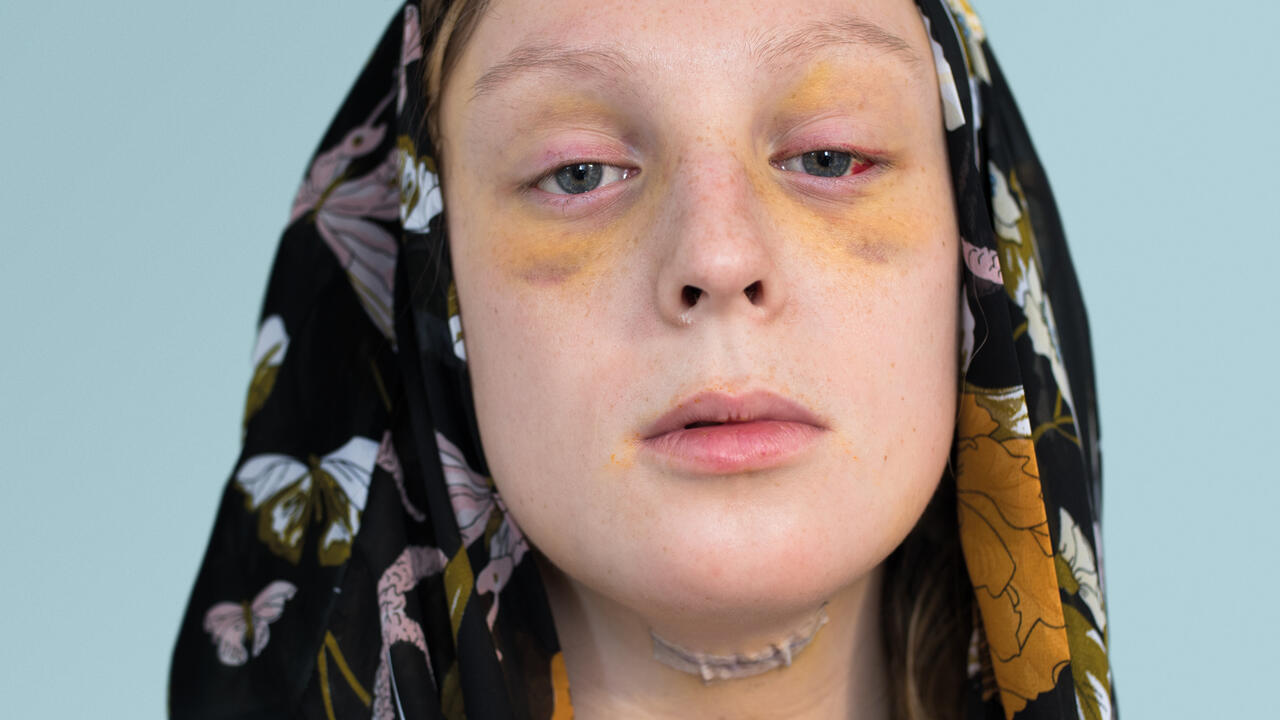Malik Nashad Sharpe Draws You Into the Dance
The choreographer’s latest work, Goner, powerfully blends movement and vulnerability, reflecting the viewer’s gaze back onto themselves
The choreographer’s latest work, Goner, powerfully blends movement and vulnerability, reflecting the viewer’s gaze back onto themselves

This piece appears in the columns section of frieze 246, ‘Dance’
As Malik Nashad Sharpe’s arm juts upwards to the ceiling, I suddenly notice how the arch of the church’s roof resembles that of the dancer’s back.
Yes, I am in a church – or, at least, what was once a house of worship. Now an art space in Bristol, The Mount Without is hosting Goner (2023/24), a solo performance by Sharpe, who also goes by the alias marikiscrycrycry.
Billed as dance horror, Goner plunges the audience into a fantasy where the protagonist (played by Sharpe) kills their group of friends, and is later punished for it. The work combines Sharpe’s endurance movement style with a horror aesthetic. Or, at least, that is what I think I’m seeing. Ambiguity is an essential element of Sharpe’s performance. Here, they refuse to explain the protagonist’s motives, or how they end up facing punishment. You must come to them; they will not come to you.

Goner is rooted in playful juxtaposition. Sometimes the music suggests we’re in a club, while the dancer’s movements – pirouetting and arching their back – are taken from classical ballet. Forcing us to contend with the contradictions between what we expect versus what we actually see, Sharpe consciously evokes the audience’s implicit biases as a source of great power for the choreography.
‘When I used to attend church, did I ever think that I would see a Black queer person move like this in one?’ I muse, as I watch Sharpe repeatedly shake their ass, half naked, against a pillar. The audience appears entirely captivated by the performance, although some look up to avoid directly ogling the dancer’s gyrating butt. One audience member stares for a time at Sharpe’s ass, then furtively checks to see whether anyone else has noticed. Others look like they’re trying to find meaning in each shake of the cheeks.

Here, we are not just silent spectators: Sharpe responds to our presence, our gaze becoming part of how the performance takes shape. At one point, Sharpe seemingly avoids blinking so as to meet our stares. Through their frequent use of repetition – with each movement increasingly energetic and unflinching – the dancer forces us to reckon with how we look.
So often when I go to see dance in the UK, I am met with this country’s fixation on tradition, and how frequently this hides more insidious and racist expectations. The performers are presented according to a Western idea of how a dancer should look and, by extension, reinforce a strict, albeit desexualised, gender binarism. Their skinny-yet-toned – and predominantly white – bodies become mannequin-like vessels for the choreography; the music remains atmospheric, but alludes to a certain class. With most dance performance, it’s as though the producers are asking us to just sit back and enjoy the movement from a neutral perspective.

In reality, of course, there’s no such thing as neutral. Even determining whether something is or isn’t neutral requires a decision on someone’s part. Why is certain music considered not distracting? Why are certain bodies allowed to be naked? Why are certain movements deemed sexual and others not?
What I find so refreshing about Sharpe’s practice is its suggestion of their awareness that audiences will never afford neutrality to their body, skin, music choices, dance moves and aesthetic. Yet, they do not respond with didactic speech or with a narrative that seeks to hold the audience’s hand as it unpacks its own biases. Instead, they leave it for us to work through ourselves. They are simply here to dance, letting our minds and eyes wander while they repeat a movement or turn their back to us. By ending Goner with a cliffhanger that asks the audience to complete the story in their own minds, Sharpe draws attention to how and who we are when we meet the work.
This article first appeared in frieze issue 246 with the headline ‘Don’t Blink’.
Main image: marikiscrycrycry, Goner, 2024. Courtesy: IMPERMANENCE, The Mount Without; photography: Paul Blakemore




















